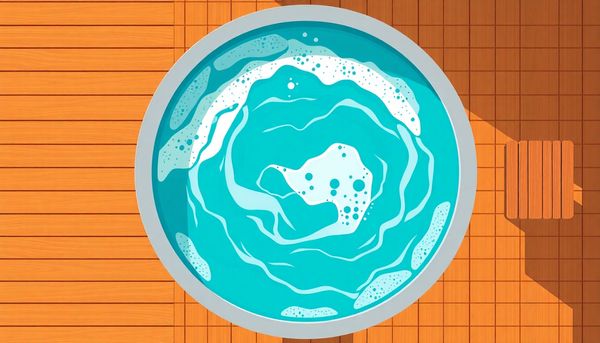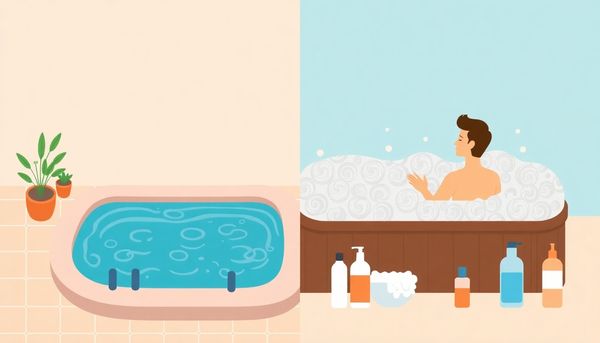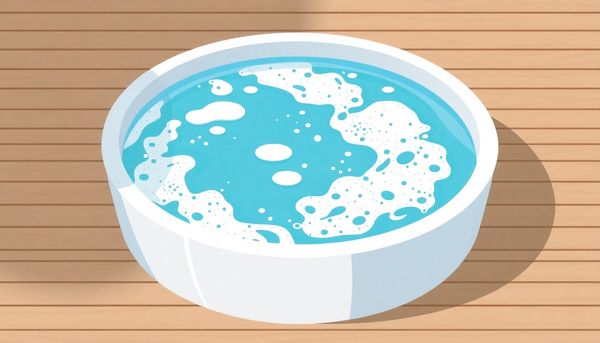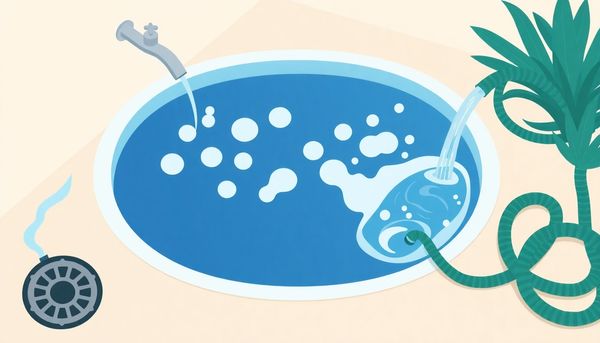Eliminate Hot Tub Foam: Quick Solutions for a Relaxing Soak
March 08th, 2024
March 08th, 2024
Stepping into a hot tub should be like entering a sanctuary—a place where the day's stress dissolves into the warm, bubbling water. Yet, nothing disrupts this serene escape quite like an invasion of unsightly foam. It creeps up on the water's surface, transforming relaxation into frustration. Once, after inviting friends over for a long-awaited soak, I found my own hot tub resembling a frothy cappuccino rather than the tranquil oasis I had promised. The embarrassment led me straight to the heart of the problem and a swift solution.
Foam in a hot tub is more than just an aesthetic nuisance; it often signals an imbalance in the water chemistry or the presence of contaminants. While it might seem trivial, ignoring foam can lead to bigger issues, affecting both the enjoyment and longevity of your hot tub. The good news? With the right approach, eliminating foam can be fast and straightforward.
Understanding the cause is key. Whether it's residual soap from swimsuits or a buildup of body oils, pinpointing the source allows for targeted treatment. This guide is designed to equip you with effective strategies to tackle foam quickly, ensuring your hot tub remains a place of uninterrupted peace. Let's transform that foamy frustration back into the bubbling bliss it should be.

When the foam in your hot tub resembles a soap opera set, there's a handy solution waiting in the wings: defoamer. It’s a bit like having a secret weapon tucked away for a bubbly emergency. A good defoamer swoops in like the hero of the story, swiftly tackling the unwanted froth, leaving the water clear and inviting for an impromptu soak.
During a particularly hectic week, when house guests announced a surprise visit, my own hot tub became a victim of foamy invaders. With no time to spare for comprehensive cleaning, I reached for the trusty bottle of defoamer. A few strategic drops later, the foam disappeared as if conjured away by magic. In minutes, the tub was ready for relaxation rather than a bubble battle.
However, defoamers are not miracle cures. They address the symptoms rather than the root cause. The persistence of foam often signals underlying issues such as imbalanced water chemistry or a buildup of oils and detergents from lotions or swimsuits. It's essential to remember that while defoamers deliver instant gratification, they are a stopgap measure. They provide temporary relief but should prompt you to investigate further.
Using defoamer allows for quick fixes, buying time until you can thoroughly clean and balance your hot tub’s water. So, while it’s a handy tool for a swift fix, make sure your next step is a deep dive into maintenance to ensure your tub stays foam-free in the long run.
Amidst the luxury of a hot tub soak, an unwanted guest often appears: foam. Enter the defoamer, a swift savior in the battle against bubbly intrusions. Yet, before reaching for that bottle with the promise of quick relief, it's crucial to understand its role. Defoamers serve as temporary fixes—akin to using an umbrella during a downpour. They scatter the foam, allowing for immediate enjoyment, but they don’t address the root cause of the foaming issue.
Consider the defoamer your backup plan. If unexpected guests are on their way and your hot tub resembles a bubble bath more than a serene spa, a quality defoamer restores tranquility in mere moments. Simply follow the product instructions, usually involving pouring a small amount into the water while the jets are running. Soon, the foam dissipates, returning the water to its clear, inviting state.
However, frequent foam sightings might signal that deeper attention is needed. Excessive use of defoamers without addressing underlying issues can lead to accumulating residues, which, ironically, may contribute to more foam over time. It's essential, then, to incorporate regular checks of water chemistry into your routine. Defoamers are most effective when part of a broader maintenance schedule that includes balancing pH, controlling calcium hardness, and ensuring sanitizers are doing their job.
Ultimately, effective defoamer use is about striking a balance—enjoying its immediate benefits while committing to long-term water care strategies. Your hot tub deserves more than just a quick fix; it merits a proactive approach to keep those foam gremlins at bay.
Skimming the surface of hot tub maintenance may suffice for a while, but true clarity lies in the details. Just as you wouldn't skip routine oil changes for your car, neglecting regular hot tub maintenance can lead to that unwelcome layer of foam. The secret to preventing foam is in establishing a consistent care routine that tackles the core issues rather than just the symptoms.
Begin with regular water testing. Keeping an eye on pH, alkalinity, and sanitizer levels can prevent the build-up of residues that contribute to foaming. Personally, I've found weekly check-ins with test strips keep surprises at bay. Adjusting these levels ensures that your hot tub remains a haven, not a bubble bath.
Cleaning the filters is another crucial step. Every month, give those hardworking filters a good rinse to clear away any oils or dirt they've trapped. A friend once shared how she discovered layers of grime in her filters led to persistent foam—cleaning them made a world of difference.
Don't overlook the importance of a quarterly deep clean. Draining the tub and giving it a thorough scrub resets your system, eliminating hidden debris and surfactants that may have slipped through the cracks. This habit not only reduces foam but extends the life of your hot tub, preserving its inviting waters for years of relaxation. Regular maintenance may seem tedious, but it’s the best way to enjoy a crystal-clear soak.
When foam transforms your hot tub from a relaxing oasis into a frothy annoyance, understanding the root cause is essential for a long-term solution. The intrigue with foam lies in its ability to appear suddenly, fueled by a cocktail of water, air, and surfactants. These surfactants, akin to the magic behind a creamy latte, lower surface tension and invite foam to the party. However, with a bit of detective work, you can banish this uninvited guest.
First, consider your hot tub’s chemistry as a starting point. Body oils, lotions, and detergents hitch a ride on your skin and swimwear, eventually overwhelming your sanitizer and leading to foam. Regularly rinsing before entering the tub can significantly reduce these contaminants. Moreover, test your water’s Total Dissolved Solids (TDS); a high reading often indicates a buildup of pesky particles causing foam.
Another clue might be lurking in your water’s hardness. Soft water with low calcium levels not only encourages foam but can also damage your tub's surface. To combat this, routinely check and adjust your water’s calcium hardness to maintain a perfect balance.
Once you've pinpointed the culprits, the ultimate remedy involves draining, cleaning, and refilling your tub. A thorough scrub of the tub’s surfaces and a filter replacement will refresh your soaking space. While a defoamer offers temporary relief, addressing the underlying issues ensures a foam-free, blissful soak every time.

Foam in a hot tub can be as unwelcome as an unexpected storm on a camping trip. Identifying the culprits behind this bubbly nuisance is crucial for maintaining the serene waters you crave. Often, the foam’s appearance is an indicator of what’s lurking beneath the surface. Personal care products, such as lotions, shampoos, and even laundry detergents, are frequent offenders. They sneak into your hot tub on skin and swimsuits, bringing with them surfactants that mix into the water and create foam when the jets are turned on.
Think about the last time you hopped into your hot tub without rinsing off after a workout or after using hair products. These simple acts can introduce oils and chemicals that disrupt the balance of your water. When your sanitizing agents become overwhelmed by these added substances, they struggle to keep the water clear and end up producing frothy bubbles instead.
Another factor to consider is the level of total dissolved solids (TDS) in your water. High TDS levels, which comprise everything from body oils to detergents to leftover chemicals, can be a foamy disaster waiting to happen. Regularly draining and cleaning your hot tub is key to keeping TDS levels in check. This maintenance not only removes potential foam triggers but also ensures your hot tub remains a haven of relaxation rather than a bubbly nuisance. By being mindful of these foam-causing culprits, you can enjoy a clear, inviting soak every time.
Understanding the chemistry of your hot tub water is like being the conductor of a symphony, ensuring every element is in harmony to keep the foamy intruders at bay. Start by grabbing a reliable testing kit—this kit is your backstage pass to the world of your tub's water chemistry. It can determine levels of pH, alkalinity, calcium hardness, and sanitizer, all crucial players in the foam prevention orchestra.
Imagine your pH level as the moderator in this ensemble. If it’s too high or too low, the water gets unruly, allowing surfactants to throw an unwelcome foam party. Aim for a pH range between 7.2 and 7.8, a sweet spot that keeps everything balanced. Alkalinity acts as the stabilizer, supporting pH levels to remain consistent. A range of 80 to 120 ppm (parts per million) is typically ideal.
Don't forget calcium hardness. Surprisingly, water that’s too soft can encourage foaming. When calcium levels are low, the water looks for minerals elsewhere—like from your tub's surfaces—leading to potential damage and more foam. Keeping calcium hardness between 150 and 250 ppm helps prevent such issues.
Once you've assessed these levels, make adjustments as needed. Add the right chemicals judiciously, letting them mingle and stabilize before diving in. By mastering these water chemistry basics, you'll not only enjoy foam-free hot tub soaks but also prolong the life and efficiency of your spa.
To tackle the stubborn foam in your hot tub, it’s crucial to identify where surfactants are sneaking in. Surfactants are like uninvited guests, arriving disguised as lotions, oils, or residues from bathing suits. These elements reduce surface tension and, when mixed with water and air, create the frothy nuisance you’re trying to avoid.
Consider the last time you hopped into your hot tub after a long day. Perhaps you slathered on sunscreen or skipped a quick rinse before diving in. These seemingly innocent choices are often the culprits behind foam. Bathers bring in body oils, makeup, and even remnants of laundry detergents on their swimsuits. Over time, these accumulate and throw your water chemistry off balance, welcoming foam to the party.
Exploring potential sources doesn’t stop there. Household cleaners and even some spa products themselves can introduce surfactants to your hot tub. While they promise cleanliness or a relaxing scent, they might also contribute to the foaming issue if not used judiciously.
To mitigate these effects, establish a routine of rinsing before entering the hot tub and encourage others to do the same. This small step can significantly reduce the amount of body oils and lotions that end up in the water. Additionally, washing swimwear without detergent or opting for an extra rinse cycle can help decrease residues. By being mindful of what enters the tub, you’ll nip foam in the bud and maintain a clearer, more inviting spa experience.
Dealing with total dissolved solids (TDS) in your hot tub is akin to managing clutter in a small space. Over time, various elements—like body oils, lotions, and even leftover cleaning agents—accumulate in the water, leading to increased TDS levels. Imagine this as a kind of invisible gunk that doesn't just vanish without intervention. High TDS levels are a common catalyst for foam, as they introduce more surfactants, those sticky molecules that encourage bubbling.
A hot tub with elevated TDS is like a party that's gotten a bit too crowded. The only way to restore order is to intervene decisively. Regularly testing for TDS with strips or kits might seem like an extra task, but it’s a reliable way to gauge whether your water is brimming with unwanted residues. Yet, if regular testing feels too tedious, there's an alternative: committing to a routine of draining and refilling your tub every three to four months. This habit not only mitigates high TDS but also refreshes your spa experience.
When I first noticed my hot tub turning into a frothy spectacle, a friend advised a simple yet effective trick: a complete drain and refill. Not only did the foam subside, but the water felt cleaner and more inviting. Addressing TDS isn't just about eliminating foam; it's about ensuring every soak is as pleasant and rejuvenating as the last.

Foam gathering atop your hot tub can be more than just an eyesore; it often signals the need for a water chemistry check-up. Each bubble and froth is a silent messenger, hinting at imbalances. Start by reaching for a reliable test strip or liquid test kit to measure the essential parameters: pH, alkalinity, and sanitizer levels like chlorine or bromine. Irregularities in these measurements can often be the culprits behind persistent foam issues.
Remember, foam is commonly born from an overabundance of surfactants—those pesky residues from lotions, oils, and soaps that sneak into your spa. But it's not just about what you can see or feel; the invisible elements matter, too. Total Dissolved Solids (TDS), those hidden particles from regular use and chemical additions, can also contribute to foaming. A high TDS reading indicates that it's time to address your water’s balance through a thoughtful drain and refill.
Beyond these tests, calcium hardness levels deserve attention. Soft water, marked by low calcium, not only fuels foam but also risks corrosion and damage to your hot tub's surfaces. Regular testing helps maintain the delicate equilibrium needed for a serene soaking experience.
Once you've gathered the test results, the path to clear water becomes clearer. Adjust the chemistry as needed, ensuring each dip in the tub is as soothing and foam-free as intended. With careful attention to these details, your hot tub will transform from frothy mess to pristine oasis.
Addressing foam in your hot tub requires a bit of detective work. Start by examining potential culprits that could be contributing to the bubble invasion. Surfactants, often at the root of foaming issues, can sneak into your hot tub through innocuous means like body oils, lotions, or remnants of laundry detergent on swimwear. Each dip in the tub potentially introduces these substances, thus amplifying the problem. Regular rinsing of swimwear and a quick shower before soaking can reduce the introduction of these unwelcome guests.
Overlooked maintenance can also lead to foaming. When sanitizers become overwhelmed, they struggle to keep the water pristine, allowing surfactants to flourish. Testing your water regularly to ensure balanced pH and alkaline levels can help keep foam at bay. High total dissolved solids (TDS), which accumulate over time, also play a significant role. If your TDS levels are high, it's time for a refresh; drain and refill your tub every three to four months to maintain optimal water quality.
Inadequate calcium hardness is another sneaky factor. Soft water tends to foam more easily than water that is properly balanced. Adjusting calcium levels will not only reduce foaming but also prevent potential damage to your tub's surfaces. By keeping a vigilant eye on these factors, you can enjoy a foam-free soak every time.
In the realm of hot tub maintenance, achieving and maintaining proper water balance is akin to mastering the art of a symphony. Each component must work in harmony to create a relaxing experience. When the water in your hot tub dances to its own tune, it often results in unwanted foam. This is where understanding water balance becomes crucial.
Start by focusing on the key players: pH, alkalinity, and calcium hardness. Keeping these elements in check ensures that your hot tub water remains inviting and foam-free. Regular testing is vital. Utilize those handy test strips or liquid kits to monitor the pH, aiming for a balance between 7.4 and 7.6. This sweet spot helps prevent surfactants from taking over, which are a common cause of foam.
Alkalinity acts as a buffer for your pH levels, stabilizing them and preventing erratic swings. Maintaining alkalinity between 80 and 120 ppm (parts per million) keeps your water chemistry on an even keel. Meanwhile, calcium hardness should hover between 150 and 250 ppm. Too little calcium leads to soft water, increasing the likelihood of foam, while too much can cause scaling.
Let’s not forget the importance of circulating and filtering your water frequently. This process not only aids in maintaining water clarity but also in dispersing chemical treatments more effectively. By ensuring all these elements are in balance, you’ll keep the foam at bay and preserve the soothing sanctuary that is your hot tub.
When foam takes over the calm waters of your hot tub, the idea of a relaxing soak becomes a distant fantasy. A thorough cleaning and refill of your spa can be the magical elixir to restore its pristine condition. Begin by completely draining the hot tub, allowing you to address the root cause of the foamy disruption. Think of this as a fresh start for your spa, akin to a rebooting of a cluttered computer.
Once emptied, the cleaning phase assumes center stage. Use a gentle, non-abrasive cleaner to scrub every nook and cranny of the tub. Remember, though, that the battle against foam is not just fought on the surface. The jets and plumbing deserve equal attention. Using a line flush can help evict those stubborn surfactants lurking in the depths of your spa's circulation system. Don't forget to clean or replace your filters; these unsung heroes capture oils and other debris that contribute to foam formation.
After ensuring every part is spotless, refill your hot tub with fresh water. This step marks the beginning of a new chapter. But, before you dive back in, test the water for pH, alkalinity, and sanitizer levels. Adjust these to create an optimal balance, deterring foam’s return. Allow the water to circulate for at least 24 hours, giving the chemicals a chance to blend harmoniously.
A clean slate, indeed, but maintaining this effort regularly can significantly reduce foam incidents. Armed with a solid routine, your hot tub will remain an inviting oasis, free from the pesky foam that once troubled its waters.

To tackle the persistent issue of foam in your hot tub, embarking on a deep clean routine is your best bet. First, arm yourself with the right tools: a gentle non-abrasive sponge, a dedicated hot tub cleaner, and a garden hose with an adjustable nozzle. Drain the water completely; this is akin to hitting the reset button on your spa experience.
Next, focus on the surfaces. Scrub every nook and cranny, paying special attention to the waterline where oils and lotions tend to accumulate. These residues often act like uninvited guests, welcoming foam to your party. My friend once thought just a quick wipe would suffice, only to find the foam making a stubborn return. Thoroughness is key.
Now, turn your attention to the filters. These heroes work tirelessly to maintain water clarity but can become overwhelmed with buildup. Use a filter cleaning solution to soak them overnight, ensuring they can efficiently capture contaminants. Once squeaky clean, reinstall them with confidence.
Finally, refill your tub with fresh water. This is not merely a physical act but a symbolic one—out with the old, in with the new. Adjust your chemical levels meticulously; balanced chemistry is your best ally against future foam invasions. Allow the water to circulate for 24 hours before diving back in. This deep clean routine is not just maintenance but a rejuvenation of your hot tub, ensuring many more foam-free soaks to come.
Bubbling bliss can quickly turn into a frothy fiasco, but eliminating foam from your hot tub doesn’t have to be a daunting task. Picture yourself preparing for a relaxing evening soak, only to find a layer of persistent bubbles. Fortunately, tackling this issue is straightforward with the right approach. First, consider using a defoamer. This quick fix temporarily dispels foam, allowing you to enjoy your spa without interruption. Yet, remember, it's akin to a Band-Aid on a larger issue—it addresses the symptom, not the cause.
Understanding what leads to foam is crucial. Surfactants, pesky little molecules that lower surface tension, are often the culprits. They come from various sources such as body oils, lotions, and detergents from swimsuits. These substances increase the water's viscosity, similar to how cream thickens coffee. To counteract these, regular water maintenance is key. Begin by checking your hot tub’s pH levels and alkalinity. Imbalances here can exacerbate foaming, so ensure these are within the recommended ranges.
Moreover, conducting a thorough cleaning every few months can prevent surfactants from building up. Drain your hot tub, scrub the surfaces, and replace or clean the filters. This routine not only alleviates foam issues but also prolongs the life of your spa. For those times when a quick fix is unavoidable—such as just before guests arrive—a foam remover offers temporary respite. Yet, the real solution lies in consistent and proper maintenance. Embrace these practices, and your hot tub will remain a haven of tranquility, foam-free and ready for relaxation.
When dealing with an unexpected bubble bath in your hot tub, the secret might just lie in the water chemistry itself. Keeping the chemistry balanced is like maintaining harmony in an orchestra; each component must work in tune with the others to avoid a discordant mess. Start by testing your water for pH and alkalinity, as imbalances here often lead to unwanted foam. A high pH level, for instance, can allow soaps and oils to survive in the water, acting as surfactants that encourage foaming.
The importance of calcium hardness is often overlooked. Low levels can create soft water, leading not only to foam but also to long-term damage to your spa surfaces. Imagine your hot tub as a concoction that needs the right amount of calcium to stay smooth and foam-free. Adjust your water’s calcium if necessary, aiming for a range that keeps your tub healthy and inviting.
Moreover, a high concentration of total dissolved solids (TDS) indicates an overload of impurities like body oils and lotions, which are major foam contributors. Regular hot tub maintenance—draining and refilling every few months—prevents this buildup. A friend of mine swears by a monthly deep clean, which not only keeps foam at bay but also extends the life of her tub. By staying proactive with your water chemistry, you can enjoy a crystal-clear soak every time, free from the interference of pesky foam.
Routine maintenance isn't merely a chore; it's the cornerstone of keeping your hot tub foam-free and enjoyable. Just like you wouldn’t skip a regular oil change for your car, maintaining your hot tub on a consistent schedule prevents foaming issues and prolongs its life. Each week, dedicate a moment to test your water chemistry. It's as crucial as checking whether your morning coffee is brewed just right. Use a comprehensive test kit to assess pH, alkalinity, and sanitizer levels, ensuring they align with recommended ranges. This proactive approach wards off the pesky buildup of surfactants that lead to foam.
Consider your hot tub’s filter as its lungs. Breathing clean air keeps you healthy, and a clean filter does the same for your hot tub. Set reminders to rinse filters every couple of weeks and replace them at least annually. A filter clogged with impurities can’t do its job, leading to decreased water quality and increased foam.
Finally, make draining and refilling the tub a quarterly ritual. Every three to four months, perform a complete water change and deep clean. This not only refreshes your tub but eliminates hidden residues. Personal experience shows that a clean slate every season keeps surprises at bay. By sticking to a diligent maintenance schedule, you transform hot tub care from a daunting task into a breezy routine, ensuring clear, foam-free soaking sessions every time.

There’s something satisfying about starting fresh, and when it comes to your hot tub, a drain and refill might be just what the doctor ordered for persistent foam issues. After all, nothing beats the effectiveness of a thorough reset. Imagine your hot tub as a blank canvas; a periodic draining and cleaning can eliminate accumulated lotions, body oils, and residual chemicals—essentially wiping the slate clean.
Begin by completely draining the tub, ensuring you follow the manufacturer’s instructions to avoid any mishaps. Once the water is out, take the opportunity to scrub the interior surfaces, focusing especially on any stubborn grime clinging to the edges. It might seem tedious, but this step removes the invisible culprits contributing to the foam. Some people find that using a gentle, non-abrasive cleaner works wonders here. After the scrubbing, rinse thoroughly to ensure no cleaning agents linger behind.
With the tub gleaming, it’s time to refill. Using a hose filter can help reduce mineral deposits, preventing future foam generation. Once refilled, test and adjust the chemical levels, allowing the water to circulate for a day before diving back in. This process not only resolves existing foam but also sets the stage for a more balanced, enjoyable soaking experience. Through regular draining and refilling every few months, you maintain a healthier spa environment, reducing the likelihood of foam and extending the life of your hot tub.
Foam in a hot tub can be more than just an eyesore—it hints at deeper issues swirling beneath the surface. Understanding the common culprits behind this foamy fiasco helps keep your soak sessions bubble-free. Firstly, personal care products often sneak into the mix. Shampoo, conditioner, and lotions, though innocuous on your skin, become unwelcome guests in your hot tub. They introduce surfactants that promote bubble formation, turning a tranquil dip into a sudsy surprise.
Moreover, think of those pool parties or family gatherings. Each person brings more than just conversation to the tub. Oils from skin, sweat, and even laundry detergents from swimsuits contribute to the frothy buildup. With every splash and dive, these elements combine, overloading the water’s capacity to stay clear. It's like inviting too many guests to a dinner party without enough chairs. The water can’t handle it all, and foam emerges as a visible sign of stress.
Water chemistry imbalances also play a starring role. Low calcium hardness, for example, creates softer water which readily foams up. If not monitored, this imbalance slowly wreaks havoc, etching surfaces and encouraging bubbles. Regular testing and maintenance act like a good detective—spotting issues before they turn into foam-fueled dramas. By tackling these foam-causing agents head-on, you ensure your hot tub remains a haven of calm, not chaos.
Every hot tub owner knows the frustration of dealing with persistent foam. While quick fixes like defoamers might offer temporary relief, a comprehensive deep-cleaning routine is the real hero in this saga. Such a routine not only banishes the foam effectively but also revitalizes your tub, ensuring a pristine soak every time.
Start by completely draining your hot tub. This step might seem daunting, but it’s essential for removing the accumulated surfactants and debris that are the primary culprits of foamy water. Once drained, use a soft cloth and a gentle, non-abrasive cleaner to scrub all surfaces, including the seats and jets. Pay special attention to hidden nooks where grime loves to hide, as these can be breeding grounds for unwanted foam.
Next, tackle the plumbing with a line flush. Flushing the lines helps remove buildup within the pipes, which can contribute to water contamination. This step ensures that the heart of your hot tub is as clean as its surface. Don’t forget to clean or replace the filters, as they trap many of the impurities that lead to foaming.
Finally, refill the hot tub with fresh water. As you do this, test and balance the water chemistry, including pH, alkalinity, and calcium hardness, to prevent future foaming issues. Allow the water to circulate for a full day, then test again to confirm everything is perfectly balanced. With these steps complete, your hot tub is not just foam-free but also primed for relaxation.

This article provided insights into maintaining your pool. Start your pool care journey today!
Want to become a pool maintenance expert? Our free Pool School course covers everything you need to know about pool care. From basic maintenance to advanced troubleshooting, you'll learn how to:
Join over 10,000 pool owners who have already transformed their pool care routine. Get started with our free Pool School course today!